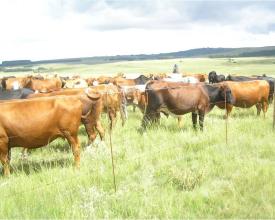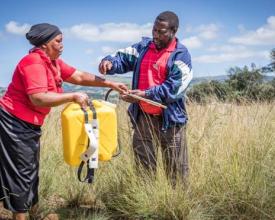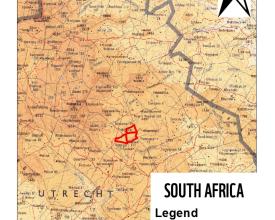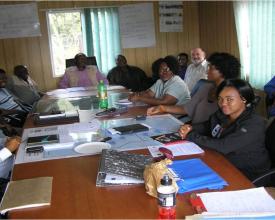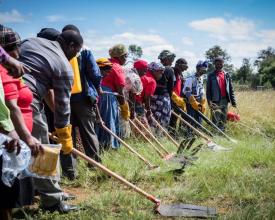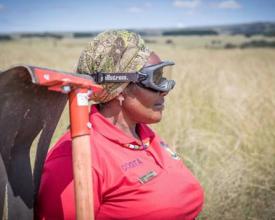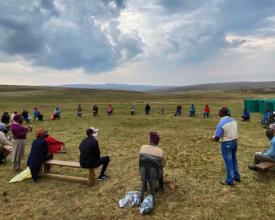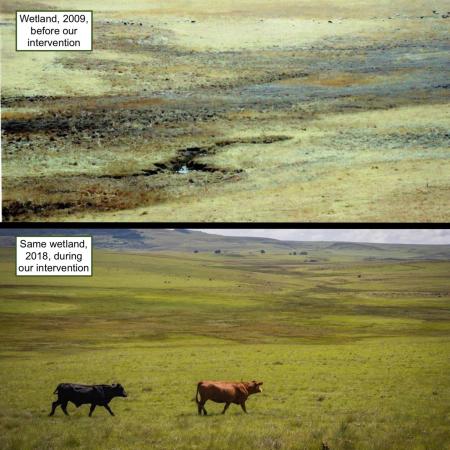
Responsabiliser les gardiens de la biodiversité
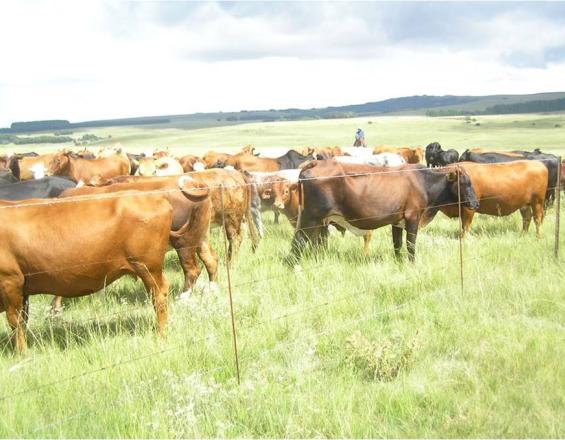
La communauté de Mgundeni a récupéré ses terres en 1999 et la communauté est actuellement dirigée par iNkosi Z.G. Mabaso. La communauté a créé le Mgundeni Trust. La propriété comprend un type de prairie, le Wakkerstroom Grassland Montane, qui sert d'habitat à d'importantes espèces d'oiseaux vulnérables et permet à la propriété de devenir une réserve naturelle. La communauté a opté pour un accord de biodiversité en tant que projet pilote dans le cadre du programme d'intendance de la biodiversité. Maintenant que la communauté dispose de capacités suffisantes, elle est passée à une catégorie d'environnement protégé (PE). La communauté souhaite continuer à faire paître son bétail sur la partie pour laquelle elle a signé l'incorporation dans l'EP, mais elle suivra des régimes de pâturage et de brûlage corrects, guidés par les résultats des évaluations de l'état du veld (3,8 ha/Au pendant 365 jours) qui ont été menées en 2014.
Contexte
Défis à relever
Le programme tente de réaliser une utilisation durable à long terme des terres prioritaires (biodiversifiées et productrices d'eau) par la conservation des zones traditionnelles appartenant à la communauté ou gérées par elle et le maintien d'une économie rurale basée sur l'utilisation judicieuse des ressources naturelles. Dans le cadre de l'intendance de la biodiversité, la terre reste la propriété du propriétaire. L'intendance de la biodiversité est particulièrement efficace dans les paysages à usages multiples où les zones prioritaires pour la biodiversité sont intégrées dans une matrice d'autres utilisations des terres. Il existe une gamme flexible d'accords d'intendance de la biodiversité qui peuvent combiner la protection de la biodiversité et la production agricole durable. L'intendance de la biodiversité convient donc à une grande variété de paysages, y compris les zones agricoles et communales.
Emplacement
Traiter
Résumé du processus
L'intendance de la biodiversité est une approche qui consiste à conclure des accords avec les propriétaires fonciers privés et communaux pour protéger et gérer les terres dans les zones prioritaires en matière de biodiversité, sous la direction des autorités chargées de la conservation en Afrique du Sud. Elle reconnaît les propriétaires terriens comme les gardiens de la biodiversité sur leurs terres. L'intendance de la biodiversité repose sur l'engagement volontaire des propriétaires terriens. Différents types d'accords d'intendance de la biodiversité sont disponibles pour soutenir la conservation et l'utilisation durable des ressources. Les programmes provinciaux d'intendance de la biodiversité visent à fournir des incitations aux propriétaires fonciers participants, en fonction du niveau d'engagement de ces derniers. Les mesures incitatives comprennent des conseils et un soutien techniques en matière de gestion de la biodiversité, tels que la lutte contre les espèces exotiques envahissantes et le brûlage des pare-feux, des dons de gibier aux propriétaires terriens par les autorités de conservation, ainsi que des possibilités de reconnaissance et de marketing. En répondant aux besoins de la communauté, tels que le développement des compétences et la création d'emplois, la protection des ressources naturelles se fait automatiquement et les membres de la communauté locale finissent par voir la valeur de la vente du bétail aux enchères, ce qui répond directement à leurs besoins financiers.
Blocs de construction
Développement des compétences en matière d'intendance
L'intendance de la biodiversité est une approche qui consiste à conclure des accords avec les propriétaires fonciers privés et communaux pour protéger et gérer les terres dans les zones prioritaires en matière de biodiversité, sous la direction des autorités chargées de la conservation en Afrique du Sud. Elle reconnaît les propriétaires terriens comme les gardiens de la biodiversité sur leurs terres. L'intendance de la biodiversité repose sur des engagements volontaires de la part des propriétaires terriens. Différents types d'accords d'intendance de la biodiversité sont disponibles pour soutenir la conservation et l'utilisation durable des ressources. Certains types d'accords d'intendance de la biodiversité sont officiellement déclarés comme zones protégées en vertu de la loi sur les zones protégées, ce qui garantit une sécurité à long terme pour les sites concernés.
Facteurs favorables
Tout projet faisant partie du programme national de gestion de la biodiversité doit se conformer à la loi sur la gestion de l'environnement national dans les zones protégées (National Environmental Management Protected Areas Act - NEMPAA) et s'assurer qu'il prend soin de la biodiversité sur sa propriété.
Leçon apprise
Le WWF-SA a appris que la formation à la gestion des incendies aide également les membres de la communauté à trouver des opportunités d'emploi dans les grandes municipalités et contribue également à la sécurité alimentaire.
Réaliser des bénéfices écologiques, économiques et sociaux
L'intendance de la biodiversité peut être importante pour réaliser les avantages écologiques, économiques et sociaux que des écosystèmes sains peuvent apporter à long terme. La gestion de la biodiversité peut stimuler le développement économique rural en créant un centre d'intérêt pour le tourisme axé sur la nature et l'utilisation durable des ressources naturelles. Cela contribue à la diversification des moyens de subsistance ruraux, en particulier dans les zones agricoles marginales. Les sites de gestion de la biodiversité peuvent également favoriser la création d'emplois et le développement des compétences grâce à la gestion et à la restauration directes des terres, ou indirectement par le biais d'activités commerciales compatibles. En Afrique du Sud, la réforme agraire se traduit souvent par de nouvelles propriétés foncières communales. Dans ces zones, la gestion de la biodiversité peut contribuer à garantir l'accès aux opportunités économiques associées aux zones protégées.
Facteurs favorables
Tout projet faisant partie du programme national de gestion de la biodiversité doit se conformer aux dispositions de la loi sur la gestion de l'environnement national dans les zones protégées (NEMPAA) et s'assurer qu'il prend soin de la biodiversité sur sa propriété.
Leçon apprise
Le WWF-SA a appris que la formation à la gestion des incendies aide également les membres de la communauté à trouver des opportunités d'emploi dans les grandes municipalités et contribue également à la sécurité alimentaire.
Impacts
L'intendance de la biodiversité est devenue l'un des outils les plus importants pour étendre le réseau sud-africain de zones protégées et de zones de conservation. Récemment, la valeur de l'approche de l'intendance de la biodiversité a dépassé le rôle de l'expansion des zones protégées et est de plus en plus considérée comme une approche permettant d'atteindre une série d'autres résultats environnementaux. Il s'agit notamment de sécuriser les infrastructures écologiques (zones stratégiques d'approvisionnement en eau), d'atténuer les effets du changement climatique, de développer les compétences et de soutenir la mise en œuvre du programme de travail sud-africain sur l'économie de la biodiversité. L'intendance de la biodiversité a la capacité de soutenir le programme de développement du pays tout en atteignant les objectifs nationaux et internationaux en matière de biodiversité. Il est évident que le programme d'intendance de la biodiversité a énormément contribué à la fois à la gestion des ressources naturelles à moindre coût et à l'amélioration socio-économique au niveau des ménages.
Bénéficiaires
La communauté de Mgundeni est le principal bénéficiaire de ce projet.
Objectifs de développement durable
Histoire

La zone environnementale protégée de la communauté de Mabaso (Mgundeni) utilisera le feu principalement comme outil de gestion des prairies afin de garantir le maintien de la valeur de la biodiversité et d'empêcher la détérioration des lisières de la forêt. Les structures de gestion se réuniront chaque année avant la saison des feux, pour passer en revue les brûlages de la saison précédente. Sur la base du plan de gestion des feux, les compartiments de gestion seront programmés pour des brûlages au cours de la saison des feux suivante et seront enregistrés en tant que plan de brûlage annuel pour la mise en œuvre. La communauté a été formée à la lutte contre les incendies avec l'aide du WWF-SA et a reçu du matériel. Grâce à cette formation, les membres de la communauté sont maintenant utilisés par la municipalité du district d'Amajuba pour lutter contre les incendies qui se propagent dans le district et ils obtiennent des emplois saisonniers à temps partiel. Les espèces suivantes ont été historiquement enregistrées sur le bien - la grue caronculée Bugeranus carunculatus (CE), l'alouette de Rudd Heteromirafra ruddi (E), le pipit à poitrine jaune Anthus chloris (V), la grue couronnée Balearica regulorum (V), l'ibis chauve Geronticus calvus (V) et l'oiseau-secrétaire Saggittarius serpentarius (NT). La région est très riche en patrimoine culturel, comme en témoignent un mur d'élevage en pierre construit à l'époque du roi Dingaan, un arbre appelé "iLembe Tree" (utilisé pour les discussions communautaires à l'époque du roi Shaka), une pierre traditionnelle pour aiguiser les lances appelée "uMkhonto sharpening stone" et une maison "Impi" (guerriers), pour ne citer que quelques-unes des caractéristiques locales. L'étude socio-économique menée dans la région a montré qu'une activité viable consisterait pour la communauté à louer ses terres à un éleveur de bétail. Cependant, la communauté a choisi de créer sa propre entreprise d'élevage durable. En 2015, iNkosi Mabaso a confirmé que le système de plans de pâturage améliorait effectivement les prairies de leur ferme et l'ensemble de la communauté a accepté que le troupeau de vaches passe de 520 à environ 650. Cette communauté a accédé à un marché commercial blanc où elle vend son bétail dans trois ventes aux enchères différentes et les gens utilisent ces fonds pour prendre soin de leurs familles et certains emmènent leurs enfants à l'école qui est très éloignée de cette communauté isolée ; cela témoigne d'une amélioration socio-économique au niveau des ménages. La photo ci-dessous montre que le changement de gouvernance sur une longue période et la volonté de réussir d'un groupe de personnes permettent de produire du bétail de bonne qualité tout en prenant soin du veld.
